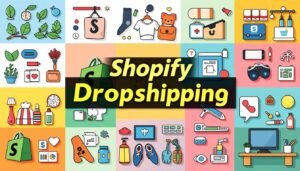I’ve worked hard to make my Shopify store special. I’ve built an email list and made interesting content. I’ve also promoted my store on social media and through ads.
I want my business to grow even more. Finding new ways to attract customers is key. This guide will show you 10 ways to make your Shopify store grow big.
Key Takeaways
- Make your Shopify store better for users and sales. This is important for growth.
- Use tools and data to make your store grow easier. This helps a lot.
- Try different ways to grow your store, like SEO and social media. This helps a lot too.
- Work with experts like GenovaWebArt to grow your store well.
- Focus on making customers happy and caring for the planet. This builds loyalty and attracts new customers.
Understanding the Significance of Continuous Growth
Growth is key for any e-commerce business. It lets you get more customers, make more money, and keep up with the competition. Growing your online store helps you become a trusted brand, keep customers coming back, and succeed for a long time.
Expanding Customer Base and Revenue Potential
New businesses mean more competition for customers. Good Ecommerce Continuous Growth plans help you reach new customers, get more sales, and make more money. With smart marketing and using data, you can grow your customer base and find new ways to make money.
Staying Relevant and Competitive in the Market
The e-commerce world changes fast. To stay ahead, your Shopify store must keep up. Growth lets you be quick to change, meet new trends, and stand out with a strong Brand Reputation Building and Customer Loyalty Optimization.
Building Brand Authority and Fostering Customer Loyalty
Consistent growth makes your store a trusted brand. By offering great products and service, you build a strong reputation. This leads to more repeat business and word-of-mouth referrals.
“Growth is never by mere chance; it is the result of forces working together.” – James Cash Penney, Founder of JCPenney
Evaluating Your Business’s Readiness for Scaling
Before you start scaling, check how your Shopify store is doing now. Look at your goals for growing. A Shopify Store Readiness Assessment helps find what’s good and what needs work. This makes sure your business is ready to grow well.
Assessing Current Business Performance Metrics
First, look at your Business Performance Analysis closely. Check things like website visitors, how many buy, and how much they spend. Knowing what’s strong and weak helps you know where to improve.
Setting Clear and Measurable Scaling Goals
After checking your business, set Scaling Goal Setting that are clear and can be measured. Your goals might be to make more money, get more customers, or sell more online. Having these goals helps you know what to do and why.
| Key Metric | Current Performance | Growth Target |
|---|---|---|
| Website Traffic | 50,000 monthly visitors | 75,000 monthly visitors |
| Conversion Rate | 2.5% | 3.5% |
| Average Order Value | $75 | $85 |
| Customer Lifetime Value | $250 | $300 |
By checking how you’re doing now and setting clear goals, you can make a plan for your Shopify store’s growth. This plan helps you grow in a smart way for the long term.

Optimizing Your Shopify Store for Scalability
As your Shopify store grows, it’s key to make your website fast and smooth. This ensures a great experience for your customers. By focusing on Shopify Store Performance Optimization and Operational Efficiency, you can grow without trouble.
Enhancing Website Performance and User Experience
Your Shopify store’s speed matters a lot. It affects how customers feel and what they do. To make your site better, try these tips:
- Make images and videos smaller to load faster
- Make your code run smoother by optimizing CSS and JavaScript
- Use top-notch Shopify themes and plugins that keep up with updates
- Use caching and CDNs to make pages load quicker
By making your Shopify store faster, you’ll make shopping better for your customers. This can lead to more sales and happy customers.
Streamlining Operational Processes and Workflows
To grow well, your Shopify store needs to run smoothly. Use Workflow Automation to make things better, like:
- Automate orders and keep track of stock
- Work with 3PL providers for better shipping
- Use tools to manage stock across different places
- Use CRM software for better customer service
Streamlining your store helps it grow without mistakes. This makes sure your customers have a great time shopping with you.
Optimizing your Shopify store for scalability is essential for accommodating increased sales volumes and customer demands.
Shopify Store Scaling
Scaling your Shopify store is a big job. It needs many strategies and tactics. You can grow your online business in many ways. Let’s look at the main parts of scaling your Shopify store.
Leveraging Dropshipping and Cross-Selling
Dropshipping can really help your store grow. It lets you sell more products and beat your rivals. Cross-selling also helps by selling more to each customer. Customers like getting more for their money.
Prioritizing Mobile-Friendly Design
Today, a mobile-friendly store is very important. A good website makes shopping easy and helps sell more. This is part of scaling your store.
Harnessing the Power of SEO
SEO is key to getting more visitors to your store. Good SEO means more people find and buy from you. This helps your business grow.
Crafting Compelling Product Descriptions
Good product descriptions sell more. They help customers know what they’re buying. This makes a strong impression and helps your store grow.
Leveraging Digital Advertising
Advertising is vital for sales and visibility. Use email, social media, and Google ads to reach more people. This is especially important when you want to grow your business.
Using these strategies can make your Shopify store better. A smart and data-driven plan is essential for growing your business. Remember, scaling your store is a journey that needs patience and effort.

“Scaling your Shopify store is not a one-size-fits-all approach. It requires a deep understanding of your target audience, a commitment to continuous optimization, and a willingness to adapt to the ever-evolving ecommerce landscape.”
Leveraging Search Engine Optimization (SEO)
Using good SEO strategies is key to getting more people to visit your Shopify store. By making your website and content better, you can show up more in search results. This brings more potential customers to your online shop.
Conducting Keyword Research and Optimization
First, find out what words and phrases people use to look for things like what you sell. Tools like Ahrefs help you see how often people search for these, who else is competing, and what they want. This helps you pick the best keywords for your Shopify store.
After picking your keywords, make your product titles, descriptions, and meta tags better. Search engines like content that’s useful and interesting to users. So, write high-quality, engaging text that speaks to your audience.
Creating High-Quality Content for Improved Rankings
Creating good content is also a smart move for your Shopify store’s SEO. By making blog posts, guides, and other useful content, you show you know your stuff. This brings more people to your website.
Think about what people are searching for when choosing what to write about. Give them what they’re looking for, and you’ll see your search rankings go up. This means more people will find your Shopify store.
“Search contributes up to 80% of all trackable website traffic, and 82% of marketers say SEO has a positive impact on their business goals.”
Harnessing the Power of Email Marketing
Unlock your Shopify store’s full potential with Shopify Email Marketing Strategies. Email marketing is a top way to connect with customers and boost sales. By building and segmenting your email lists, you can send personalized and targeted campaigns that speak to your audience.
Building and Segmenting Email Lists
Creating a strong Email List Building plan is key. Start by getting email addresses from your website visitors. Offer special deals or discounts to make them want to buy. Use email automation tools to make your campaigns better and keep in touch with customers.
Crafting Personalized and Targeted Campaigns
Take your marketing up a notch with Personalized Email Campaigns. Sort your email lists by what customers like and do. This way, you can send content that really speaks to each person. Automate your emails so customers get the right message at the right time, building stronger connections and sales.
“Email marketing has one of the highest ROIs of any marketing channel, making it a cost-effective strategy for Shopify store owners.”
Shopify’s email marketing tools have ready-made templates for important emails. Use these to make your work easier and get more out of your Shopify Email Marketing Strategies.

Email marketing lets you connect with customers, increase sales, and build lasting relationships. This way, you can grow your Shopify store to even greater heights.
Utilizing Social Media Platforms Effectively
Social media is key for Shopify store owners to grow their business. Shopify Social Media Marketing helps you find many customers. It also helps you build a strong online community around your brand.
Identifying Relevant Platforms for Your Target Audience
Finding the right social media platforms is crucial. Facebook and TikTok are just a few examples. Each has its own special features and users.
By knowing what your audience likes, you can pick the best platforms. This way, you get the most value for your time and effort.
Engaging with Your Audience and Building Community
After picking the right platforms, it’s time to talk to your audience. Make content that looks good and feels right. This will make your followers happy and loyal.
Ask people to like, comment, and share your posts. This helps you grow your community. Using content from your followers and working with influencers can also help your brand grow.
Learning how to use social media well can open many doors for your Shopify store. It can bring more people to your site and make your customers very loyal. Using social media smartly can really help your business grow.
“More than 40% of consumers use their social feeds to discover new products.”
Social media is now a big way for people to find new things. It’s very important for any Shopify store’s marketing plan. Shopify Social Media Marketing helps you reach and talk to your audience. This can bring more people to your site and help you sell more.
Implementing Effective Inventory Management
As your Shopify store grows, good Shopify Inventory Management is key. It helps you manage stock well and use automated tools. This way, you save money and get ready for more customers.
Optimizing Stock Levels and Reducing Overhead Costs
Try ABC analysis to sort your items. It puts them into A (high-value), B (medium-value), and C (low-value) groups. This helps you focus on the most important items.
Use safety stock to protect against demand changes. And use demand forecasting to guess what you’ll need next. This balance helps avoid too much or too little stock, saving you money.
Leveraging Automation and Integrated Solutions
Look into Automated Inventory Systems that work with your Shopify store. They give you live updates on your Stock Optimization. These tools make tasks like filling orders and checking stock easier, saving you time.
- Use barcoding and RFID technology for better tracking and reports
- Connect your Shopify with multichannel inventory management systems for a single view of stock
- Use demand forecasting algorithms to guess future needs and buy smart
With these steps and tools, you can improve your Shopify Inventory Management. This saves money and helps your store grow.

Exploring Scalable Fulfillment and Shipping Options
As your Shopify store grows, managing orders and shipping well is key. Looking into third-party logistics (3PL) providers can help. It makes your Shopify Scalable Fulfillment better and keeps customers happy.
Evaluating Third-Party Logistics (3PL) Providers
When picking a 3PL for your Shopify, think about these things:
- Fulfillment center capabilities: Find providers with good warehouse systems and machines for big orders.
- Shipping and delivery options: Make sure they offer many shipping choices and fast delivery.
- Scalability and flexibility: Pick a 3PL that grows with your business and handles busy times.
- Inventory management: Look for providers that track inventory and orders live to avoid stockouts.
Implementing Efficient Order Processing and Tracking
Using Automated Order Processing can make your Shopify better. Connect your store with a 3PL’s system for smoother orders. This cuts down on mistakes and lets customers track their orders live.
“Repeat customers on Shopify generate 300% more revenue than first-time shoppers, emphasizing the value of building customer loyalty through efficient fulfillment.”
By using a 3PL Provider Selection, you can grow your Shopify. It ensures a smooth and scalable Shopify Scalable Fulfillment for your customers.
Enhancing Customer Service and Support
As your Shopify store grows, great customer service is key. Use omnichannel support and chatbots to make customers happy. This helps keep them coming back and grows your business.
Implementing Omnichannel Support Strategies
Customers want to talk to you in many ways. Offer support on email, live chat, social media, and in person. This way, they can choose how they want to contact you, making them happier and more loyal.
A study found that companies with omnichannel support keep 89% of their customers. This is much better than 33% for those without. Giving a consistent and personal experience helps build strong customer relationships.
Leveraging Chatbots and Automation for Efficiency
Chatbots and automation make your customer service better. Chatbots answer simple questions fast, so your team can help with harder ones. Most people want to solve problems on their own, showing they like automated help.
Using Shopify Customer Service Optimization like Automated Customer Service makes things smoother. It helps your team work better and keeps customers happy, even when it’s busy.
Omnichannel Support and Automated Customer Service are important for better customer service. They help your Shopify store grow and keep customers happy for a long time.

Expanding into New Markets and Channels
As your Shopify store grows, it’s time to explore new markets and channels. Look for growth chances and trends in your field. This helps you stay ahead and find new ways to make money.
Think about selling more things and making money in different ways. You could sell in other countries, offer more products, or sell in stores and online.
Identifying Growth Opportunities and Emerging Trends
Keep up with the latest in your field by watching market trends and what customers like. Do deep research to find new chances that fit your goals. This might mean selling in new places, finding new customers, or using new ways to sell.
Diversifying Product Offerings and Revenue Streams
It’s key to sell different things and make money in different ways. This means selling more stuff to your current customers or finding new products. By doing this, you can reach more people, not rely on just one thing, and make your business stronger.
| Key Expansion Benefits | Percentage of Businesses Reporting |
|---|---|
| Expanded market reach | 72% |
| Access to established customer bases | 64% |
| Heightened brand visibility | 83% |
| Reduced distribution costs | 56% |
Shopify’s Markets feature helps you grow globally and spot trends. It makes selling in different places and to different customers easy. You can sell online, to businesses, and in stores all from one place.
With Markets, you can quickly start selling in new places. You can also make shopping better for buyers and see how well things are selling. It all happens from one place, making it easy to grow your store.
Conclusion
Scaling your Shopify store is exciting and tough. It needs a full plan. Knowing Shopify Scaling Conclusion and Ecommerce Growth Summary is key. This helps you see if your business is ready.
Make your store ready for growth. Use SEO, email marketing, social media, and manage your stock well. This will help your e-commerce business grow big.
Scaling is a journey that keeps changing. You need to be flexible, creative, and focus on your customers. Start this journey and watch your store grow.
Keep making your store better for your customers. Make things easier and find new ways to grow. Always aim for Shopify Scaling Conclusion and Ecommerce Growth Summary. This will help your business grow strong and ready for the future.
FAQ
What are the key strategies for scaling a Shopify store?
To grow a Shopify store, focus on making it fast and easy to use. Use SEO and content marketing to attract more visitors. Also, send emails and use social media to reach more people.
Manage your stock well and find ways to ship items quickly. Improve customer service and explore new markets and ways to sell.
Why is continuous growth essential for an e-commerce business?
Growing your e-commerce business is key. It helps you get more customers and make more money. It keeps you competitive and builds your brand.
It also helps you save money, innovate, attract investors, and stay strong.
How can I evaluate my Shopify store’s readiness for scaling?
Check how well your store is doing now. Look at sales, customers, and how things work. Find any problems or areas to get better.
Then, set goals for growing your business. Make sure these goals match your big plans for your store.
What are the key steps to optimize a Shopify store for scalability?
Make your website fast and easy to use. Improve how it loads and use the right plugins and themes.
Make your work processes better. Use tools and automation to do less work and make fewer mistakes.
How can I leverage search engine optimization (SEO) to drive organic traffic to my Shopify store?
Find out what people search for online. Use those words in your store’s titles and descriptions. Make sure your store is seen as an expert in your field.
Create useful content like blog posts. This helps your store show up in search results.
What are the benefits of implementing effective email marketing strategies for a Shopify store?
Good email marketing keeps customers interested and brings in sales. Build a list of email addresses and send out targeted messages.
Use tools to automate emails. This helps you keep in touch with customers and get them to buy from you again.
How can I utilize social media platforms to scale my Shopify store?
Find where your customers are online. Post interesting content regularly. This builds your online presence.
Work with influencers to reach more people. Get your followers to interact with your brand. This creates a community around your store.
Why is proper inventory management crucial for scaling a Shopify store?
Good inventory management saves money and ensures orders are filled on time. Use methods like ABC analysis and safety stock.
Automate your inventory system. This makes your store more efficient and ready for more sales.
What are the benefits of exploring scalable fulfillment and shipping options for a Shopify store?
Finding better ways to ship items helps you grow. Look at third-party logistics and automated systems.
This makes sending orders smoother. It also makes customers happy and keeps them coming back.
How can enhancing customer service and support contribute to the scaling of a Shopify store?
Better customer service keeps customers happy and loyal. Offer support through many channels and use chatbots.
This lets your team focus on helping with big issues. Happy customers are more likely to come back and tell others about your store.
What are the key considerations for expanding into new markets and distribution channels?
Look for new places to sell and trends in your field. Offer different products and sell in different ways.
This reduces risk and brings in new customers. It also keeps you ahead of the competition.







